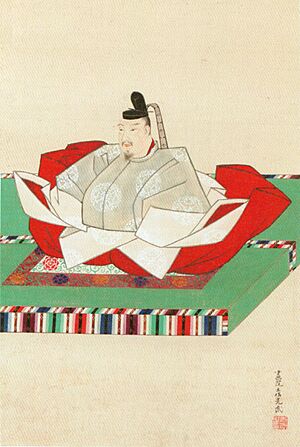Emperor Go-Kashiwabara facts for kids
Quick facts for kids Emperor Go-Kashiwabara後柏原天皇 |
|||||
|---|---|---|---|---|---|
 |
|||||
| Emperor of Japan | |||||
| Reign | November 16, 1500 – May 18, 1526 | ||||
| Coronation | April 28, 1521 | ||||
| Predecessor | Go-Tsuchimikado | ||||
| Successor | Go-Nara | ||||
| Shōguns | |||||
| Born | Katsuhito (勝仁) November 19, 1462 |
||||
| Died | May 18, 1526 (aged 63) | ||||
| Burial | Fukakusa no kita no Misasagi (深草北陵) Kyoto | ||||
| Issue more... |
Emperor Go-Nara | ||||
|
|||||
| House | Yamato | ||||
| Father | Emperor Go-Tsuchimikado | ||||
| Mother | Niwata (Minamoto) Asako | ||||
| Signature |  |
||||
Emperor Go-Kashiwabara (後柏原天皇 (Go-Kashiwabara-tennō)) was the 104th emperor of Japan. He was born on November 19, 1462, and his personal name was Katsuhito (勝仁). He became emperor on November 16, 1500, and ruled until May 18, 1526. During his time, the power of the Imperial family was at its lowest point. This was because of the Ōnin War, which had caused a lot of trouble in Japan.
Contents
Family Life
Emperor Go-Kashiwabara was the first son of Emperor Go-Tsuchimikado. His mother was Niwata (Minamoto) Asako.
He had several children with his ladies-in-waiting:
- With Kajūji (Fujiwara) Fujiko:
* First daughter: Princess Kakuten (1486–1550) * First son: (born 1493) * Second son: Imperial Prince Tomohito, who later became Emperor Go-Nara * Fifth son: Imperial Prince Kiyohiko (1504–1550), who became Imperial Prince Priest Sonten
- With Niwata (Minamoto) Motoko:
* Third son: Imperial Prince Priest Kakudō (1500–1527) * Second daughter: Princess Kakuon (1506–?) * Sixth son: Imperial Prince Hirotsune (1509–1536), who became Imperial Prince Priest Gen'in
- With Takakura (Fujiwara) Tsuguko:
* Fourth son: Doko (1503–1530)
Key Events During His Reign
Emperor Go-Kashiwabara became emperor in 1500 after his father passed away. However, his family, the Imperial Court, was very poor after the Ōnin War. They were so poor that he could not even afford the important coronation ceremony.
Finally, in 1521, after 21 years, he was able to have his coronation. This was possible thanks to money given by Honganji Jitsunyo and the Muromachi Bakufu, which was the military government at the time.
Because of the war, many noble families of the court were scattered. The Imperial Court in Kyoto had very little money. This meant the Emperor's power was at a very low point.
Important Moments
- Bunki 1 (1501): The former military leader, Ashikaga Yoshimura, was sent away from the capital. He went to live in Suō Province and changed his name to Ashikaga Yoshitane. He gathered many supporters and military forces to help him.
- Bunki 2 (1502): Minamoto Yoshitane was given a higher rank by the Emperor.
- Bunki 3 (1503): There was a big drought during the summer.
- Eishō 1 (1504): A terrible famine hit Japan, meaning there was not enough food for many people.
- Eishō 5 (1508): A new rebellion started in the capital, Miyako. The military leader, Hosokawa Masamoto, was killed. This gave former-Shōgun Ashikaga Yoshitane a chance to return. He marched his troops into the capital and took control again. From this year, Yoshitane became the 10th shōgun of the Muromachi period.
- Eishō 9 (1512): After some conflicts with Korea, the Emperor made agreements that helped improve relations with the Korean government.
- Daiei 5 (1525): All ceremonies at the Imperial Court had to be stopped. This was because there was no money to pay for them.
- Daiei 6 (1526): Emperor Go-Kashiwabara died at 63 years old. He had ruled for 26 years. He was found in his archives, which are like a historical record room.
Emperor Go-Kashiwabara is buried at the imperial tomb called Fukakusa no kita no misasagi (深草北陵) in Fushimi-ku, Kyoto.
Court Officials
The Kugyō (公卿) were a small group of very powerful men who worked for the Emperor. Even when the Emperor's actual power was low, these officials still held important positions. They were usually from noble families and had a lot of experience.
During Emperor Go-Kashiwabara's reign, this group included:
- Sadaijin (Minister of the Left)
- Udaijin (Minister of the Right)
- Naidaijin (Minister of the Center)
- Dainagon (Chief Counselor)
Eras of His Reign
In Japan, periods of time are often named after the Emperor's reign. These are called nengō. Emperor Go-Kashiwabara's reign included several nengō:
See also
| Regnal titles | ||
|---|---|---|
| Preceded by Emperor Go-Tsuchimikado |
Emperor of Japan: Go-Kashiwabara 1500–1526 |
Succeeded by Emperor Go-Nara |

